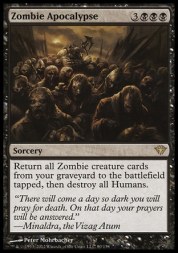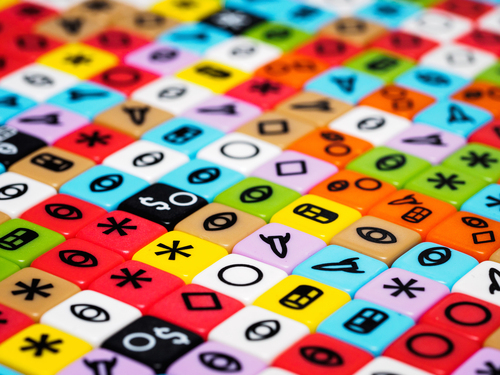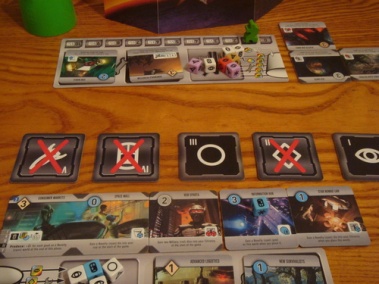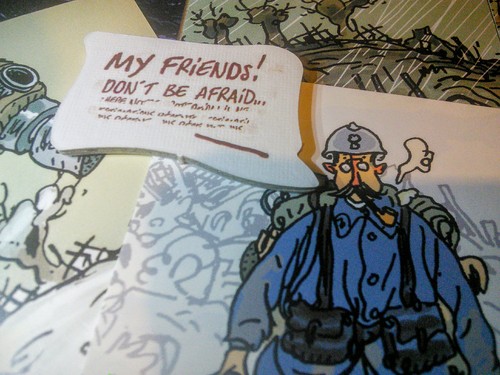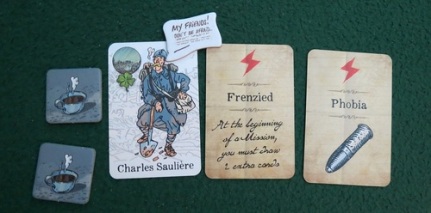Full disclosure: Last game night was an attempt to enjoy myself and stop worrying about a house move which is becoming ridiculously complicated. In an attempt to cure myself of a massive solicitor induced pain in the arse I self-administered many pints of Shropshire Gold. The views in this round-up may be affected by slight inebriation thus rendering them all bollocks. On we go!
7 Wonders
Players: 7 ( Plays 2-7)
Duration: 1 hour
If you like drafting then you will love 7 Wonders. Draft card, play card, repeat 17 times, end. 7 Wonders is a civilisation builder set over 3 Ages. At the start of the game each player is randomly dealt a Wonder Board which represents one of the 7 Wonders of the Ancient World. At the bottom of the board are three slots that represent the stages of your wonder and a single resource type (either timber, stone, clay or ore) that your civilisation produces. Players are then given three coins and the game starts.
At the beginning of each Age each player is dealt seven cards from that Ages deck. Cards represent structures that you can build and come in a variety of types. Brown cards produce raw materials (either timber, stone, clay or ore), grey cards represent manufacturing (looms, glassworks or printing), blue cards are civilian structures (straight victory points), green are for three types of scientific research (points are awarded for collecting sets), yellow cards are commercial ventures (produce resources or provide coins), red cards are military (points at the end of each round depending on your neighbours military) and purple cards are guilds (points based on specific end-game criteria).

When a player gets their cards they choose one and pass the rest to the next player (clockwise in Age 1 and 3 and anti-clockwise in Age 2). Once all the players have chosen a card they are all revealed simultaneously and played. Many cards have a build cost such as coins or the symbols on other cards. For example a Baths requires one stone, if a player has a structure that produces stone they can build the Baths for free or they can pay a neighbour some coins if they have a stone producing structure. Alternatively a player can discard their card to get 3 coins. Lastly, players can play a card facedown into their next available Wonder slot (providing they can get the resources). Wonders mostly provide straight victory points but some grant a unique ability or some kind of resource. Play continues until each player has only two cards. They draft one, discard the other then that age ends and military points are awarded. At the end of the third Age you total up the points represented by your drafted cards and the player with the most points is the winner.
7 Wonders is one of those games where it is very difficult to decide whether you are doing well or not especially with the full 7 players. When the game ends and the scores are tallied from the huge combination of possible cards it can be a little anticlimactic after all that drafting frenzy. It’s a good game with a lot to think about but don’t be surprised when it ends in a whimper.

Mostly you will be looking at the civilisation you and your neighbours are building. Usually there is a good card to draft but you might want to forgo it so that the guy next to you doesn’t finish that whopping scientific combo. Do you want to build military structures or would that get you stuck in an escalating arms race? The game plays quickly and is a lot of fun especially with a lot of players as cards are swiftly passed from one player to the next. My description may make it sound a lot more complex than it is and the scoring is a bit of a mathematical exercise but for those that want a bit of a meatier filler it is well worth a shot.
Dark Moon
Players: 5 (Plays 3-7)
Duration: 90 minutes
Dark Moon is set in a failing spaceship where players are desperately trying to complete events before one of the ship’s three key systems breaks down. The twist is that some of the players are infected with an alien virus and are attempting to sabotage the mission and destroy the ship. At the beginning of the game players are dealt cards telling them whether they are infected or not, one player is randomly chosen as the ship commander and then the game starts.
The players as a group need to complete four events to win the game. If there is no event or one has just been completed the commander draws two event cards, chooses one and then discards the other. Each event card has a different difficulty represented by the number of successes that are needed to complete it. Difficult cards take longer to complete but can give some kind of bonus whereas easy cards may actually have a penalty on completion.

Success in Dark Moon is determined by rolling and submitting dice. The faces of the dice have a value from around -2 to +2 depending on the dice but there are always four negative numbers and two positive numbers. When a player rolls they do it behind their individual screen meaning that the other players can never be sure that they are telling the truth about all their rolls. Also whenever a dice is used the player loses it until the beginning of their next turn meaning players may not want to contribute too much even if they have rolled successfully, seeding suspicion in their crewmates minds.
On their turn players can take an action. They can attempt to Repair one of the ship’s 3 systems (engine, communications or life support) by rolling two dice and submitting one. If it’s positive then the repair is a success and one damage token is taken off that system otherwise it stays as it is. A player can Call a Vote on a fellow player they suspect which, if successful, confines them to quarantine limiting their actions. A player can Lone Wolf to place progress on the current Event card. They roll 3 dice, submit 2 and if they are both positive then they are successful. Infected players may Reveal as an action meaning they show their true malicious intentions and then get access to a set of alternate Infected actions to play on their next turn. Alternatively a player can Issue an Order to another player which gives them 2 actions. This sounds great but it they are infected then they may decide to take a reveal action and then an infected action without waiting for their turn.
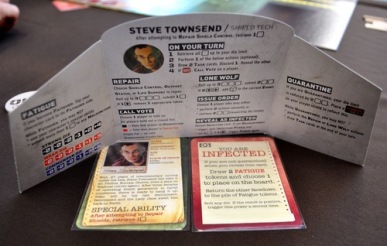
After their individual player action the player draws two tasks from a task deck and chooses one to put to the team. In turn order players decide whether they can contribute to the task and if so they roll their dice (again in secret) and submit at least one to the task. After all players have submitted dice the totals are added up and compared to the value of the task card. If the dice total is equal to or higher than the value of the task card then one success token is played on the current event card. If not a key system gets damaged. Humans win when the fourth event card is completed and infected win if a key system takes maximum damage and is destroyed.
I am still not sure whether or not I even like traitor games. If the opportunity for the traitor to sabotage the game doesn’t appear then you are usually just playing a fairly basic co-op with one or two players playing sub-optimally, the big reveal never materialises and the players start coasting to a dull finish. My first experience of Dark Moon had been fairly pedestrian as every player (including myself as an infected) seemed to be rolling success after success. Any sneaky attempt at sabotage would have been fairly obvious so I just had to reveal late and hope for success. This play was quite different. As an infected (again) I decided to bomb a key task early which made it fairly obvious I was one of the bad guys but managed to damage a system almost to destruction. The identity of my key conspirator then fell between two players who were constantly submitting bad dice and failing tasks. Ironically neither of them were my infected buddy and it was actually the commander who had quietly been picking bad events from the beginning.

This second game was a lot more fun because it had a narrative. A player turned bad right from the start and through unlucky dice rolls the group tore itself apart with suspicion before an assumed innocent was revealed as the mastermind. This is when a traitor game works. Being surrounded by good people is important but a game like this must produce a story for it to work. Often this doesn’t happen and so the game dies on the vine and comes to an unsatisfying conclusion. For me personally this games length is definitely in it’s favour. It’s a bit longer than something like Saboteur where rounds can play in just 10 minutes but doesn’t go as long as Battlestar Galactica which can take almost 4 hours. 90 minutes is just enough time to get in a good story arc but not enough to feel like time wasted if very little happens. Dark Moon is a good game when it goes right and I would recommend it for those on the fence about the whole traitor mechanic. Just try and ignore the artwork that looks like a cover from a PS2 game!











